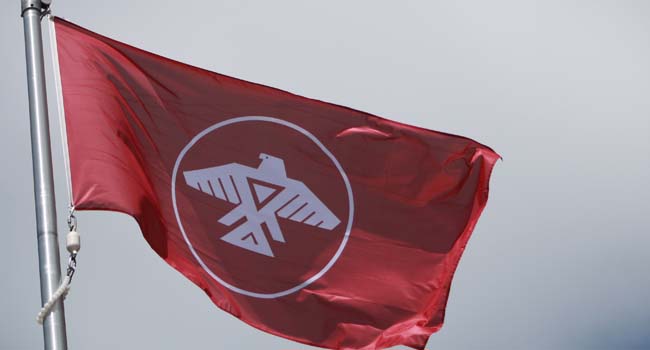Flags: whose land is it, anyway?
 By Maurice Switzer
By Maurice Switzer
Flags have always fascinated me.
How amazing that a single piece of cloth, fluttering in the breeze, can represent the past, present and future of millions of people who call themselves nations.
Pennants of all shapes and sizes have prompted the most ordinary of men to summon up courage they never knew they had and charge headlong into almost certain death on the battle field.
Strategically positioned within camera range, flags bestow credibility on televised speeches by politicians, perhaps making their actual words sound more articulate or insightful than they actually are.
Even hanging limp on their standards behind judges and civil servants, flags appear to endorse decisions and justify rulings.
My adolescent card collections included athletes like Jackie Robinson and Rocket Richard, Canadian prime ministers and American presidents, great historic figures like Thomas Edison and Sir Francis Drake, and flags of all the world’s independent nations.
There were only 100 countries then, at least double that today due to the shedding of much of the colonization imposed by European powers. Just three of them — Britain, France and Spain – competed for centuries to see who could plant the most flags in vast territories around the globe whose occupants regarded the Europeans in much the same way as today we would view alien invaders from another planet.
My social studies texts contained etchings that depicted lost sailors like Jacques Cartier in heroic pose, swords pointed skyward, flags firmly planted in ground their feet had just touched, but who were already claiming it in the name of their foreign kings.
The textbooks are more thorough these days, and students learn that “spreading civilization” does not equate to killing indigenous populations or stealing their land. Empires have morphed into Commonwealths, and former colonies have become sovereign nations – with their own flags.
In Canada, high court decisions are forcing governments to consider the inevitability of living up to constitutional pledges to recognize the inherent rights of First Peoples to manage their own affairs in the way they did for 10,000 years before the Vikings, Cartier, and Sir John A. Macdonald washed up on their shores.
Along with other trappings of nationhood, First Nations have always had banners to identify themselves as distinct peoples, ornately-carved staffs bearing Eagle feathers in equal number to their member communities or council fires.
So far, the consensus among First Nations envisions self-governing Indigenous entities functioning within the Canadian federation. Indians are not de facto separatists, at least not if Canada is willing to live up to its treaty obligations to share the land and its bountiful resources.
That’s why visitors to 600 band offices and public celebrations like pow-wows are likely to see First Nations demonstrating respect by allowing federal and provincial flags to be unfurled alongside their own Eagle Staffs or contemporary-style community banners. That’s appropriate, given that our ancestors agreed by treaty to permit peaceful settlement in our traditional territories.
Unfortunately, that respect is not always reciprocated.
Flags are primarily intended to represent the territories of nations. So in North Bay, for example, you might expect to see federal and provincial flags flapping above city public spaces. But one city park also showcases a British Union Jack, an Italian tri-colour, a banner designed to represent Francophone presence in the province, and the flag of the air wing of the Canadian Armed Forces.
North Bay should be proud of its ethnic heritages, and of the longstanding presence and community contributions made by personnel stationed at the local Canadian Armed Forces base. It is entirely appropriate for these groups to celebrate their membership or history by designing flags to fly in their offices or parade squares.
But in no way do such flags identify who has title to the lands over which they fly.
Sudbury, a more enlightened community to the west, decided to erect 100 poles on both sides of a major downtown overpass and display the flags of many of the world’s nations as a local landmark. The first two flags motorists see when approaching the overpass from the north are those of the Anishinabek
Nation – a white Thunderbird on a red ground – and the Metis – a white infinity symbol on blue background.
These were the first peoples to live on the land in this part of the world. It is most fitting for Sudbury to recognize that fact.
On June 26, 2014, the Supreme Court of Canada ruled for the first time that a First Nation can claim title to specific tracts of land within its far-reaching traditional territory. There are over 800 more outstanding land claims to be resolved across Canada.
Communities like North Bay need to be mindful of the winds of change, and ensure that the flags blowing in these breezes are ones that truly reflect the past, present, and future.
Maurice Switzer is a citizen of the Mississaugas of Alderville First Nation. He flies an Anishinabek Nation flag over the North Bay home where he lives and pays city, provincial, and federal taxes.


